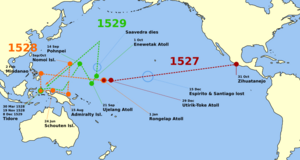Álvaro de Saavedra Cerón facts for kids
Álvaro de Saavedra Cerón (often called Álvaro de Saavedra) was a brave Spanish explorer. He sailed across the Pacific Ocean a long time ago. We don't know exactly when or where he was born. But it was in Spain, around the late 1400s or early 1500s. He was a relative of Hernán Cortés, a famous Spanish leader. Saavedra went with Cortés to Mexico (then called New Spain) in 1526.
Contents
Saavedra's Big Trip Across the Pacific
In 1527, Hernán Cortés planned a new journey. He asked his cousin, Álvaro de Saavedra, to lead it. The main goal was to find a lost group of ships. These ships were part of the Loaísa expedition. But Saavedra also had a secret mission. He was to find new lands in the Pacific Ocean. He also needed to bring back valuable spice plants.
Saavedra and his crew set sail on October 31, 1527. They left from Zihuatanejo, Guerrero, in Mexico. Two of their ships, the Espiritu Santo and the Santiago, were lost in a storm. They were never seen again.
On December 29, their last ship, the La Florida, saw land. It was the Utirik-Toke atolls. On January 1, 1528, they saw the Rongelap-Ailinginae atolls. Both are in the Marshall Islands. They named these "Islas de los Reyes" (Islands of the Three Wise Kings). This was because it was close to the Epiphany holiday.
On February 2, 1528, the La Florida reached the Philippines. The next day, they stopped at a small island near Mindanao. This was 95 days after they started their journey. This trip made Saavedra the first person to cross the Pacific Ocean from the Americas.
On March 30, 1528, the La Florida arrived at Tidore. This was a Spanish base in the Moluccas. Here, they found the remaining men from the Loaísa expedition. Saavedra's crew joined them to fight the Portuguese. The Portuguese were in the nearby island of Ternate.
Trying to Sail Back Home
Saavedra needed to follow his orders. He also had to bring more help to the Spanish in Tidore. So, he set sail for New Spain on June 14, 1528.
On June 24, 1528, the La Florida found the Schouten Islands. They landed on Yapen. They called these "Islas de Oro" (Golden Islands) and "Payne" island. They kept sailing along the coast of western New Guinea. On August 15, they found the Admiralty Islands. They landed on Manus and named it "Urays La Grande" (Urays the Big).
Then, they sailed north. They discovered the Nomoi Islands in the Carolines. But strong winds pushed them back. They were forced to return to the Moluccas. They arrived back in Tidore on November 19, 1528.
On May 3, 1529, Álvaro de Saavedra tried again. He sailed south first. Again, he went along western New Guinea and reached Manus. Then he headed north. On September 14, he discovered Pohnpei and Ant in the Carolines. On September 21, they found Ujelang Atoll in the Marshalls. They called it "Los Pintados" (The Painted Ones) because the people there had tattoos.
On October 1, they discovered Enewetak Atoll. They named it "Los Jardines" (The Gardens). This was because it was beautiful and the people were friendly. Soon after, Saavedra died. Pedro Laso took over as commander. They sailed north, but they couldn't find good winds to take them east. Pedro Laso also died. So, they decided to turn back. They returned to the Moluccas, arriving at Halmahera near Tidore on December 8, 1529.
The Portuguese captured them there. They were held for five years. In 1534, the eight surviving crew members finally made it back to Spain.
Did Saavedra Reach Hawaii?
Some people wonder if Spanish explorers reached the Hawaiian Islands. This would have been two centuries before Captain James Cook arrived in 1778. For 250 years, Spanish ships called galleons sailed across the Pacific. Their route passed south of Hawaiʻi on their way to Manila. The exact route was kept secret. This was to protect Spain's trading business.
In Saavedra's journey, land was seen to the north on November 28, 1527. This was about where Hawaii is. But they couldn't find it again after searching for two days. Also, the two ships that disappeared, the Santiago and Espiritu Santo, might have reached Hawaii.
There is an old Hawaiian story. It talks about white people arriving on the islands many generations ago. Chief Wakalana welcomed them. It's possible these visitors were members of Álvaro de Saavedra's crew.
See also
 In Spanish: Álvaro de Saavedra Cerón para niños
In Spanish: Álvaro de Saavedra Cerón para niños


